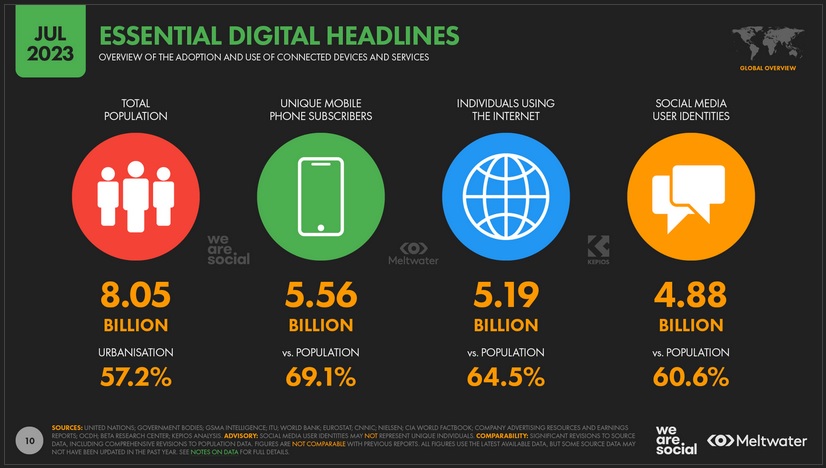Practical Ways To Teach The Concept Of Digital Citizenship Along With 9P's Of Digital Citizenship
10th October 2023

We live in a digital age where the use of digital technology like the internet, social media, or digital platforms is on the rise. Nowadays, every child has access to every digital platform from a very young age.

Source: datareportal.com
According to datareportal.com, 95% of the world's internet users use mobile phones for at least some of the time. Now, after witnessing this scenario every teacher must take actionable steps to educate every child about digital citizenship and to use digital platforms responsibly, safely, and ethically.
In this blog post, we will be sharing some of the effective ways to teach about digital citizenship to every child focusing on the “9 KeyPs” of digital citizenship.
So, without any further delay, let’s get started.
1. Passwords
An essential element of being a responsible digital citizen is knowing how to create secure passwords. Teachers must guide students during virtual online teaching on the significance of using strong and unique passwords for each online account they have. They can also introduce helpful password management tools like LastPass, which enable students to securely store and manage their passwords.
2. Private Information
In today's digital world, safeguarding personal information is of utmost importance. Teachers play a critical role in guiding students on how to protect their private details like addresses, emails, and phone numbers. An excellent resource for teaching students about internet privacy and the significance of keeping personal information confidential is the Common Sense Digital Citizenship curriculum.
3. Personal Information
While personal information may not directly identify someone, it is still essential to teach students about making conscious decisions regarding what they share online. Teachers can encourage students to think critically about the information they share and with whom they share it.
4. Photographs
Students need to be aware that photographs they share online can reveal private details unintentionally. Teachers can educate students about the potential risks of sharing photographs that may contain sensitive information like license plates or street signs. Additionally, they can teach students how to disable geo-tagging features and the importance of understanding facial recognition software.
5. Property
Understanding copyright and intellectual property rights is a vital component of digital citizenship. Teachers can guide students on how to respect the property rights of others and create a license for their own work using resources such as Creative Commons. It is crucial to emphasize that simply citing "Google Images" is not sufficient, and students should trace the original source of an image.
6. Permission
During virtual online teaching, you must focus on teaching students about seeking permission and properly citing the work they use is an essential aspect of digital citizenship. Teachers can familiarize students with the concept of plagiarism and teach them how to give credit to the original creators of the content they use.
7. Protection
To be responsible digital citizens, students must understand the risks posed by viruses, malware, phishing, ransomware, and identity theft. Teachers can educate students about these potential threats and teach them preventive measures to protect their devices and personal information.
8. Professionalism
Digital citizenship also includes understanding the difference between academic and social interactions online. Teachers can teach students about netiquette, online grammar, and the importance of being globally competent. They can also foster an understanding of cultural taboos and provide guidance on resolving cultural disconnects respectfully.
9. Personal Brand
Helping students develop their personal brand online is a crucial aspect of digital citizenship. Teachers can encourage students to reflect on their digital footprint and how they want to be perceived online. Students need to understand that the content they share can have long-lasting consequences and may be difficult to erase completely.
Practical Ways of Teaching 9P’s of Digital Citizenship
Now, that we know about 9P’s of Digital Citizenship, it’s time to learn how you can teach them the concept of it practically.
1. Experiential Knowledge
While proactive knowledge is important, students also need experiential knowledge to become effective digital citizens. Here are some strategies teachers can employ to provide students with the necessary experience.
2. With Real-Life Examples
Teachers can warn students against online scams by exposing them to real-life examples. By discussing current scams and cons sourced from reputable websites like Snopes, students can develop critical thinking skills and become more vigilant online.
3. Turn Students into Teachers
Empowering students to become teachers themselves is an effective way to reinforce their understanding of digital citizenship. Teachers can assign students the task of creating tutorials or presentations that expose common scams and ways to protect oneself. By dissecting cons and scams, students not only enhance their own knowledge but also contribute to the digital literacy of their peers.
4. Collaborative Learning Communities
Collaborative learning experiences will provide students with valuable opportunities to practice digital citizenship. Teachers can encourage students to participate in collaborative learning projects that involve connecting with peers from diverse backgrounds and cultures. By engaging in activities like online blogging, sharing work on public platforms, and interacting with students from different countries, students gain a deeper understanding of global perspectives and the importance of effective communication online.
Educate Students About Digital Citizenship For Their Safety
We are witnessing the revolution of the digital age, which makes digital technology platforms accessible to everyone around the world. Nowadays, we are seeing that children have access to digital technology like, the internet, and social media from a very young age.
It’s every teacher’s responsibility who’s involved in virtual online teaching, to teach about digital citizenship concepts properly. In this blog post, we have shared some of the effective ways of teaching the “9 Key Ps” of digital citizenship practically which will help students to become effective digital citizens in an inter-connected digital world.
Remember, digital citizenship is not just about teaching students to use technology, it's about teaching them to use technology responsibly, ethically, and safely. By instilling these values, teachers are empowering students to become responsible digital citizens who can positively contribute to the digital world.
We believe education should be accessible for everyone. That’s why we don’t charge for our blogs. Find the right course that will help you in your career with us, contact us at - +1800–212–6400. You can mail us at act@asiancollegeofteachers.com.
Written By : Abhishek











